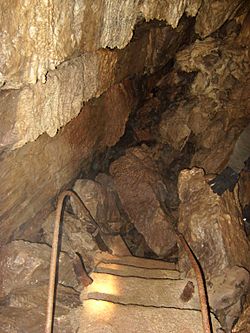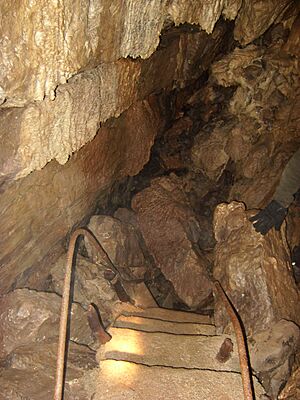Skirwith Cave facts for kids
Quick facts for kids Skirwith Cave |
|
|---|---|

Remnants of a stairway in Skirwith Cave
|
|
| Location | Ingleborough, North Yorkshire, [UK] |
| OS grid | SD 7095 7378 |
| Length | 1,000 metres (3,300 ft) |
| Elevation | 275 metres (902 ft) |
| Discovery | 1934 |
| Geology | Carboniferous limestone |
| Entrances | 1 |
| Difficulty | III |
| Hazards | water, loose boulders |
| Access | Permit |
| Cave survey | 1980 NCC line survey on Cavemaps |
Skirwith Cave is a cool cave found on Ingleborough mountain in North Yorkshire, England. It's a special type of cave called a solutional cave, which means it was formed by water dissolving rock. This cave was once open to visitors as a show cave from 1964 to 1974. Today, it's no longer open to the public, but experienced cavers still explore its passages. Skirwith Cave is also part of the important Ingleborough Site of Special Scientific Interest, which protects its unique natural features.
Contents
Exploring Skirwith Cave
The main way into Skirwith Cave is through a small opening in a shakehole. A shakehole is like a small dip or hole in the ground, often found in areas with limestone. Once inside, you enter a beautifully decorated passage that was part of the old show cave.
Inside the Cave Passages
The floor of this first section used to be flat and easy to walk on. However, a pile of fallen rocks, called a boulder choke, now blocks the way. There were once steps over this choke, but they are now covered. The show cave used to end at a five-metre (16 ft) waterfall.
Beyond the waterfall, the cave continues into a long, often low and wet passage. After several hundred meters, this passage reaches a sump. A sump is a section of the cave that is completely filled with water, so you have to dive through it. Skirwith Cave has three short sumps, each separated by small sections of dry passage. The fourth sump has been explored by divers for 24 metres (79 ft) until they reached another underwater boulder choke. Interestingly, this cave doesn't have any streams or rivers flowing into it along its 1,000-metre (3,300 ft) length.
How the Cave Formed
Skirwith Cave is a solutional cave, meaning it was created by water dissolving the rock. It formed in the lowest layers of a type of rock called Great Scar limestone. This limestone was laid down during the Carboniferous period, which was a very long time ago. Below this limestone, there are older, harder rocks from the Ordovician period that water cannot easily pass through.
Water Flow and Connections
The cave slopes upwards towards an area called Crina Bottom. Water from the Boggarts Roaring Holes, located on the other side of the valley, flows into Skirwith Cave. When there's a lot of rain, extra water from Crina Bottom also drains into the cave. Scientists have even found a small part of the cave that connects to Lower Hardgill Pot, which is about 400 metres (1,300 ft) away in Crina Bottom. The water from the cave eventually comes out, or resurges, where the limestone meets the older, harder rocks.
History of Discovery
People living nearby probably first entered Skirwith Cave in 1934. Members of the Yorkshire Ramblers' Club explored more of the upstream passages in 1935. By 1947, the cave had been fully explored up to the first sump. The sumps, which are the underwater sections, were explored later in 1965 and 1966 by members of the Happy Wanderers Cave and Pothole Club.
When it Was a Show Cave
Skirwith Cave opened as a show cave for visitors in 1964. It was always a smaller attraction compared to other nearby show caves like Ingleborough and White Scar. It was also a bit harder for visitors to reach. Unfortunately, nearby quarry work caused some of the cave's roof and rock piles to become unstable. Because of this, the cave had to close to the public in 1974. Today, there isn't much left above ground to show that it was once a popular show cave.


